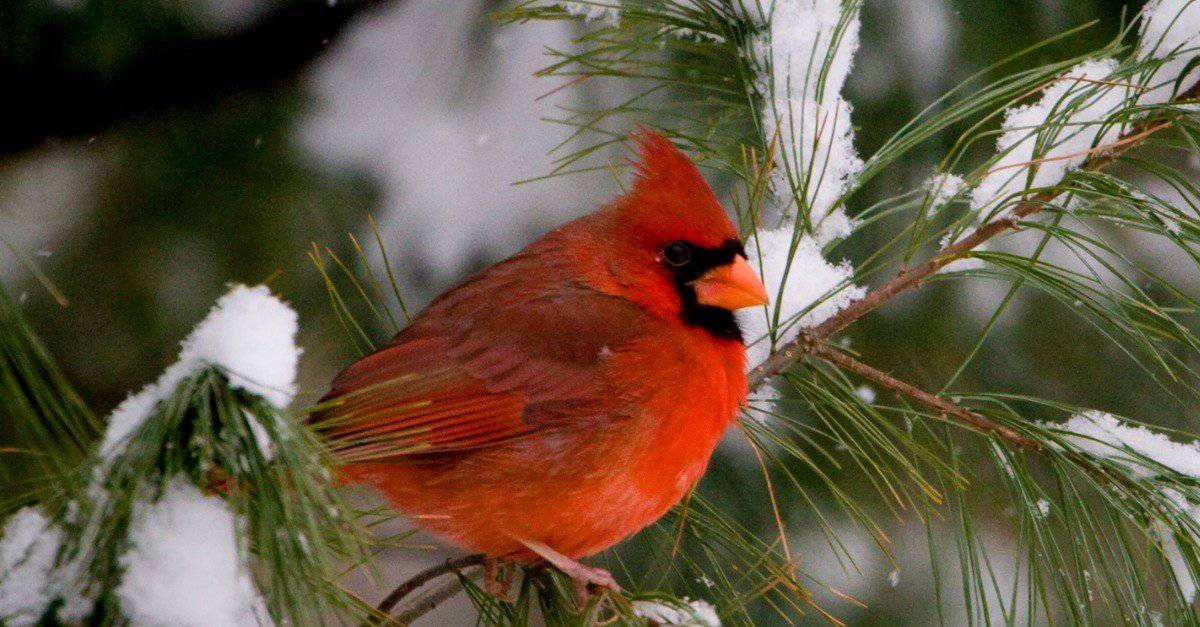A songbird is a type of bird that has the unique ability to sing complex vocalizations. They are known for their beautiful, melodic singing, which often sounds like music. Songbirds have been around for millions of years and can be found in almost every part of the world.
Songbirds sing for many reasons, including communication, courtship, territorial defense, and self-expression. For example, some species use songs as a way to attract mates, while others may use them to announce their presence or establish boundaries within a certain area. In addition, some species even mimic other animals’ calls or noises from the environment they inhabit, as seen with mockingbirds! It is believed that singing helps songbirds identify potential dangers by alerting them to nearby predators or unfamiliar areas where they might not feel safe.

13 Types of Songbirds
There are hundreds of types of birds that sing. Therefore, we have laid out a few of our favorites below.
1. Hermit Thrush
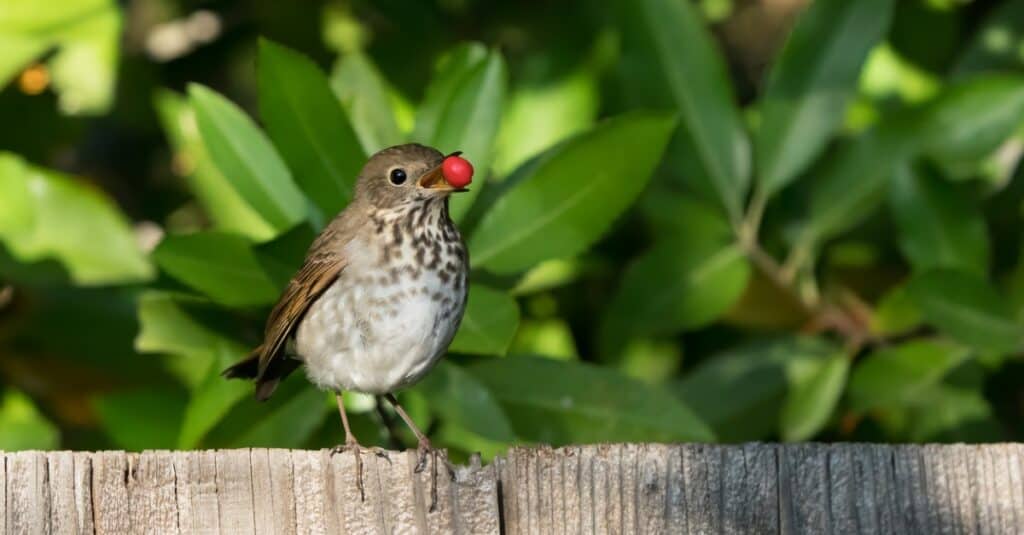
The hermit thrush is one of the greatest songbirds and sounds like a flute when it sings.
©iStock.com/Wendy/Jeff Sparks/Torquemada
The hermit thrush is a bird native to North America. It is part of the Turdidae family and has gray-brown upperparts, white underparts with dark spots, and a speckled breast. Its wings are long and rounded, and its tail is relatively short. The hermit thrush’s song consists of flute-like notes that ascend in pitch before ending abruptly. They sing for a variety of reasons, including territorial defense, mate attraction, courtship, or even just because it feels good! They also use their songs as alarms if they sense danger nearby. The males tend to sing more than the females during the breeding season, but both sexes will join in occasionally throughout the year. Therefore, it is one of the greatest songbirds in the world.
2. Veery Thrush
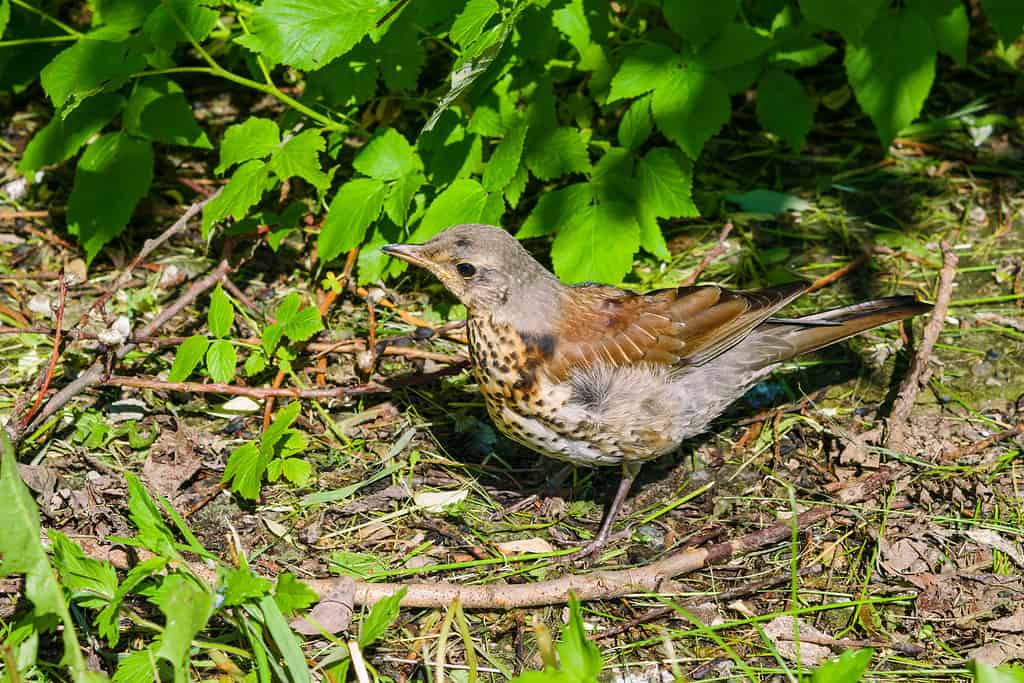
The veery thrush bird has songs that are distinctive with multiple notes that become more complex.
©iStock.com/Lyubov Demus
A veery thrush (Catharus fuscescens) is a species of songbird native to North America. It is small-to-medium sized, with a mottled gray and brown body, white throat and breast, and reddish tail feathers. Veeries can be found in deciduous forests during the summer months, where they often sing their sweet songs from high perches like trees or shrubs.
The songs of these birds are quite distinctive and usually have multiple notes that become more complex as the bird becomes more excited or agitated. They tend to sing most actively in the early morning hours but may also call out throughout the day when conditions are right. The purpose of singing for veeries is thought to be primarily related to attracting mates. However, it has been suggested that it might also play an important role in territorial defense or even social communication between individual birds!
3. Wood Thrush
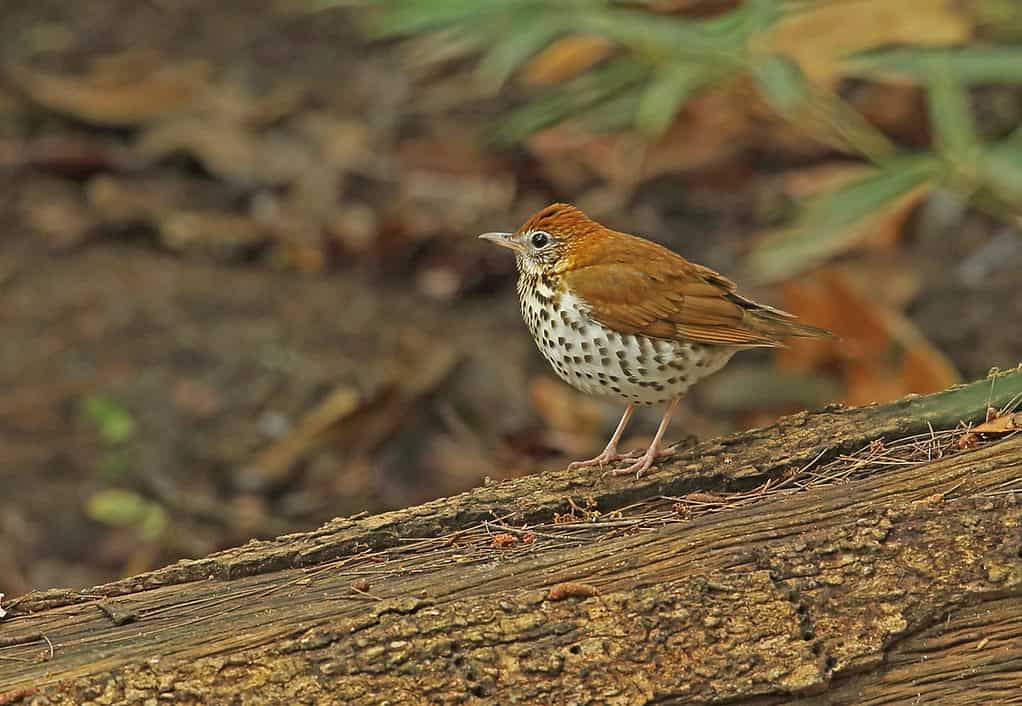
The wood thrush is one of the greatest songbirds and can be heard during dawn and dusk hours.
©iStock.com/Neil bowman
The wood thrush (Hylocichla mustelina) is a species of greatest songbirds that can be found in eastern North America. It is recognizable by its grey-brown upperparts, reddish-brown spots on the breast, and a white eye ring. The wood thrush’s song is one of the most recognizable in nature. It consists of three to four notes followed by a trill. The male wood thrush sings primarily during dawn and dusk to attract mates or defend his territory from other males. They also sing throughout the day when they are disturbed or feel threatened by predators. Wood thrushes feed mainly on insects, berries, seeds, and snails, as well as fallen fruits from the trees above them.
4. House Wren
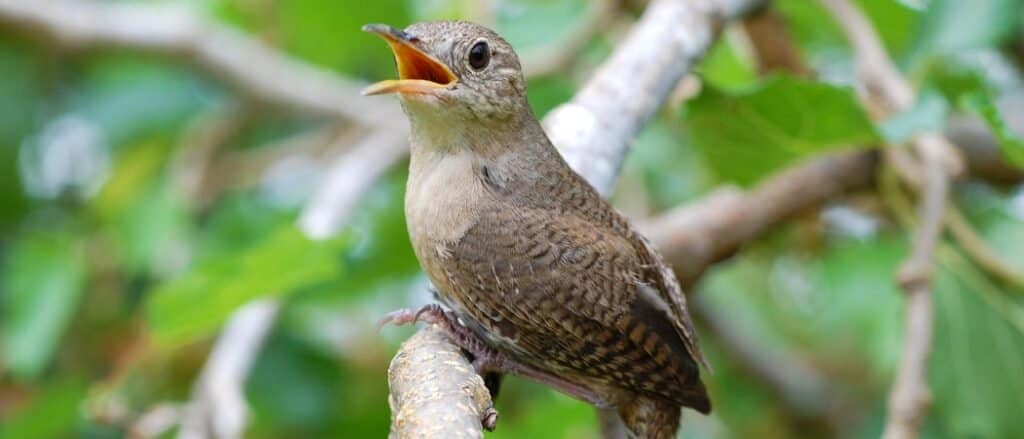
The house wren is one of the greatest songbirds.
©Gualberto Becerra/Shutterstock.com
A house wren (Troglodytes aedon) is a small songbird native to North and South America. It has brown upperparts with white spots, a light-colored belly and tail, and a dark line on its cheeks. The male has an orange throat patch during the breeding season. Its call is usually described as loud and chattering, often including mimicry of other birds’ songs. They sing to attract mates or defend their territory from intruders. During the breeding season, they may also sing at night in order to lure moths away from nearby trees – this behavior is known as “moth singing.” Female house wrens are also able to make sounds that humans cannot hear. These ultrasonic vocalizations are used for communication between parents and offspring, therefore, making it one of the greatest songbirds.
5. Baltimore Oriole
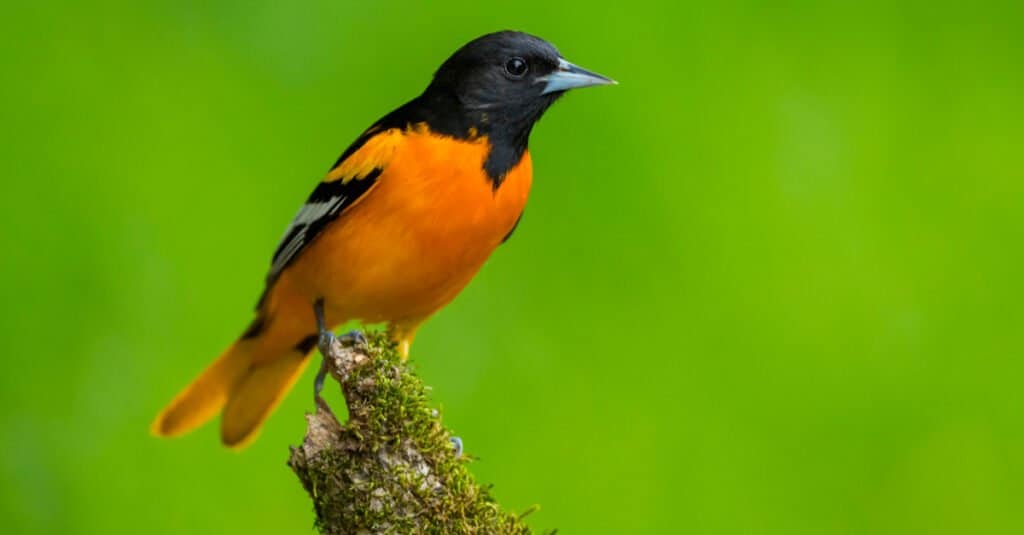
The Baltimore oriole is a common songbird in North America.
©Agami Photo Agency/Shutterstock.com
The Baltimore oriole (Icterus galbula) is a species of the greatest songbirds native to North America. It has a bright orange chest and black head, wings, and tail feathers. The male Baltimore oriole’s song is a rapid series of thin whistles that sound like “or-lee, or-lee” with an occasional trill at the end. Females typically sing a few notes but not as often as males. The reason why they sing varies from individual bird to individual bird. Some may sing for territorial purposes, while others are simply showing off their skills in order to attract potential mates. Both male and female Baltimore orioles also produce short calls when flying between trees or during social interactions such as courtship displays or group activities like nesting building.
6. Brown-Streaked Song Sparrow

The brown-streaked song Sparrow is one of the greatest songbirds that use its singing to find mates.
©iStock.com/Vronja_Photon
The brown-streaked song sparrow (Melospiza melodia) is a small passerine bird found across North America and Eurasia. They can be identified by their greyish-brown streaked plumage, white belly, and short conical bill. The song of the brown-streaked song sparrow consists of several notes that are often repeated in ascending order. These birds sing to find mates and also mark territory boundaries. They also use songs as alarm calls when predators are near or during territorial disputes with other birds. In addition to singing, they communicate through various visual displays, such as raising their head feathers or flicking their wings up and down rapidly.
7. House Finch
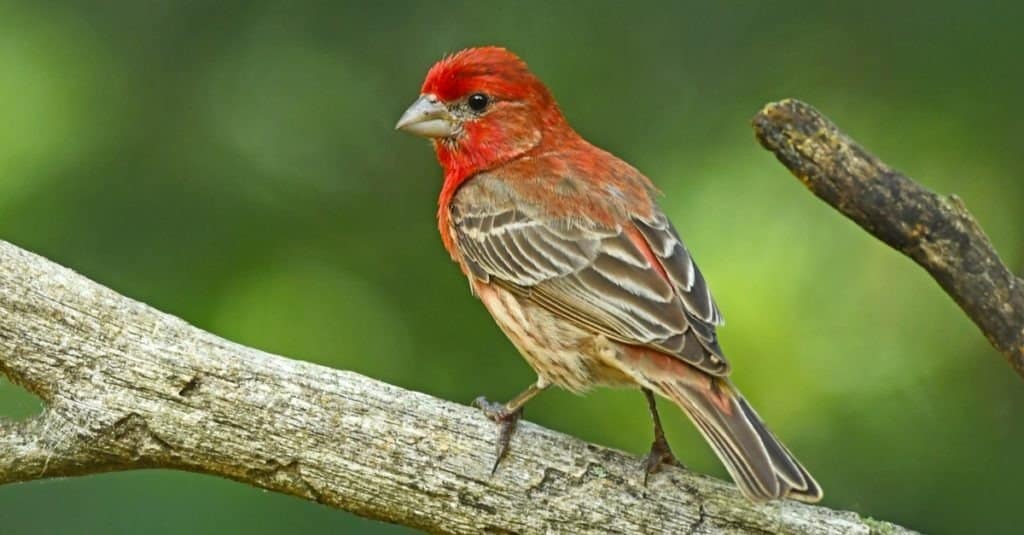
The house finch is one of the greatest songbirds that sing with sweet, simple notes.
©Brian A Wolf/Shutterstock.com
A house finch (Carpodacus mexicanus) is a small, sparrow-sized bird native to North America. Its body has a brownish-red coloration, and its wings are streaked with white markings. The males have more brightly colored plumage than the females and sport rosy red faces and breasts. A house finch’s song is composed of sweet, simple notes that sound like “cheerily,” “hirrily,” or “purty purty.” They sing to attract mates, establish territories and proclaim their presence in the area. House finches can be found near residential areas as well as parks, gardens, woodlands, and forest edges where there are plenty of shrubs for them to build their nests in.
8. Northern Mockingbird
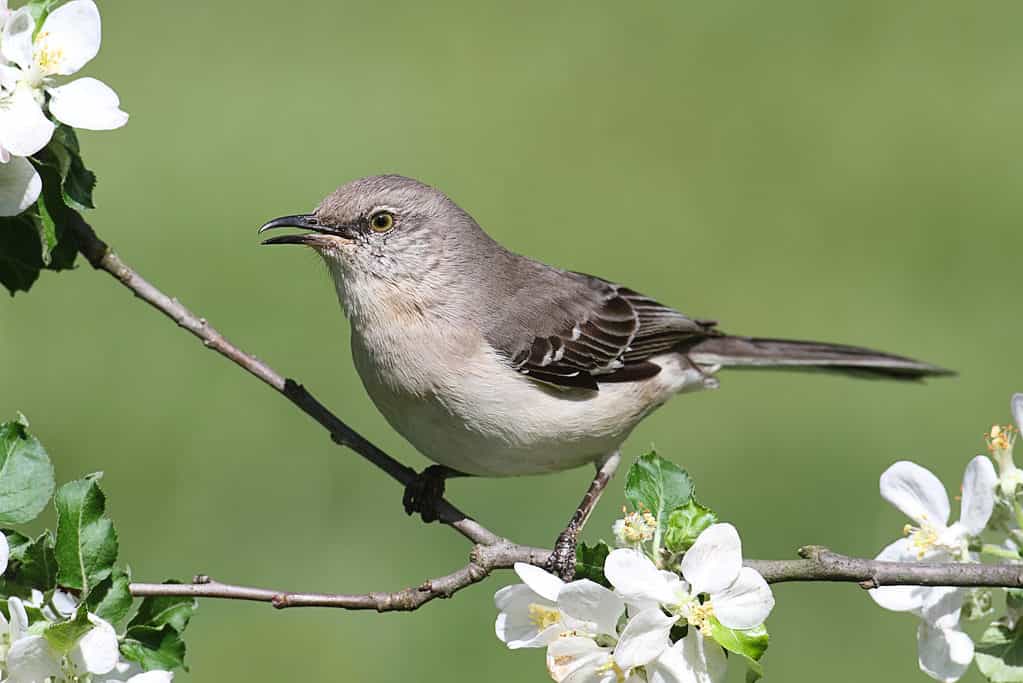
The northern mockingbird can imitate sounds from up to 30 different birds, making it one of the greatest songbirds.
©Steve Byland/Shutterstock.com
A northern mockingbird is a species of songbird native to North America. It is well-known for its wide variety and complexity of vocalizations – in fact, it has been known to imitate the sounds of up to 30 different birds! Its standard song features short phrases repeated two or three times before changing and can be heard at any time of day or night during the breeding season (April–July). The northern mockingbird sings to defend its territory from other males as well as attract mates. It also uses various songs and calls to communicate with members of its own species. The bird’s passion for singing has made it the state bird in Arkansas, Florida, Mississippi, Tennessee, and Texas!
9. Brown Thrasher

The brown thrasher songbird sings at dawn and dusk to attract mates and mark its territory.
©iStock.com/johnandersonphoto
The brown thrasher is a species of bird native to North America. It is known for its striking ruddy-brown plumage and long, thin beak, which it uses to feed on insects and other small creatures found in the ground. The song of the brown thrasher consists of loud, melodious whistles interspersed with a variety of harsh notes that are often mistaken for those of other birds. Therefore, it is known as one of the greatest songbirds. They sing at dawn and dusk as well as throughout the day when they feel secure. This singing serves many different purposes: to attract mates, warn off potential predators, mark their territory, or simply because they enjoy it!
10. Northern Cardinal

Northern cardinals are one of the greatest songbirds and can be heard from long distances away.
©Rob Palmer Photography/Shutterstock.com
The northern cardinal (Cardinalis cardinalis) is a songbird native to North America. It has bright red plumage, and the males have a black face mask and crest. The females are paler in color with brownish-red feathers. These birds are active during the day, and they feed on seeds and insects found in trees, bushes, or even on the ground. Northern Cardinals have a unique song that can be heard from long distances away. They sing a series of clear notes that sound like “what-cheer!” or “purty purty purty,” which is often repeated several times throughout their song. They primarily use their singing as part of courtship behavior to attract mates; however, they will also sing for territorial reasons or just out of joy!
11. Rose-Breasted Grosbeak
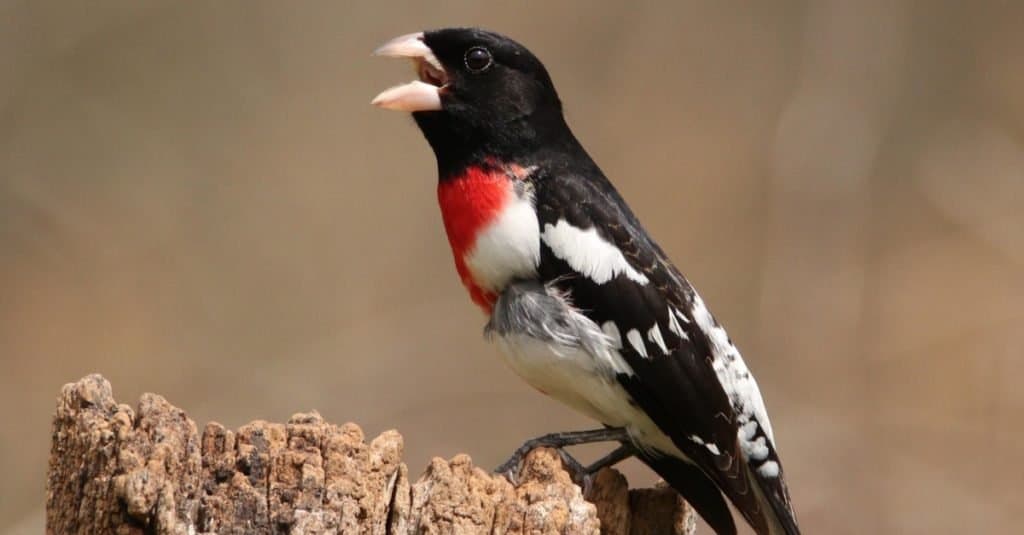
Rose-breasted grosbeak males and females engage in duets together making them one of the greatest songbirds.
©Mark W. Holdren/Shutterstock.com
The rose-breasted grosbeak (Pheucticus ludovicianus) is a medium-sized songbird native to North America. It has a black head, white belly, and chestnut/red chest. The male birds also have striking white wing bars. With its strong bill, it can feed on many types of seeds and fruits as well as insects such as grasshoppers and caterpillars. They are usually seen in open woodlands, parks, gardens, and suburban areas across the United States and Canada during the spring migration season from April to June. Their song is a melodious mix of whistles and trills that vary between individuals but generally consist of several phrases repeated over an extended period of time – sometimes up to five minutes or more!
Male grosbeaks sing mainly in order to attract potential mates, while females may join in occasionally with duets or counter-singing. During the breeding season, they will often combine their songs with physical displays such as fanning out their tails or flicking their wings open, displaying flashes of bright colors such as reds, yellows, blues, or greens, depending on what type they are!
12. Tanager
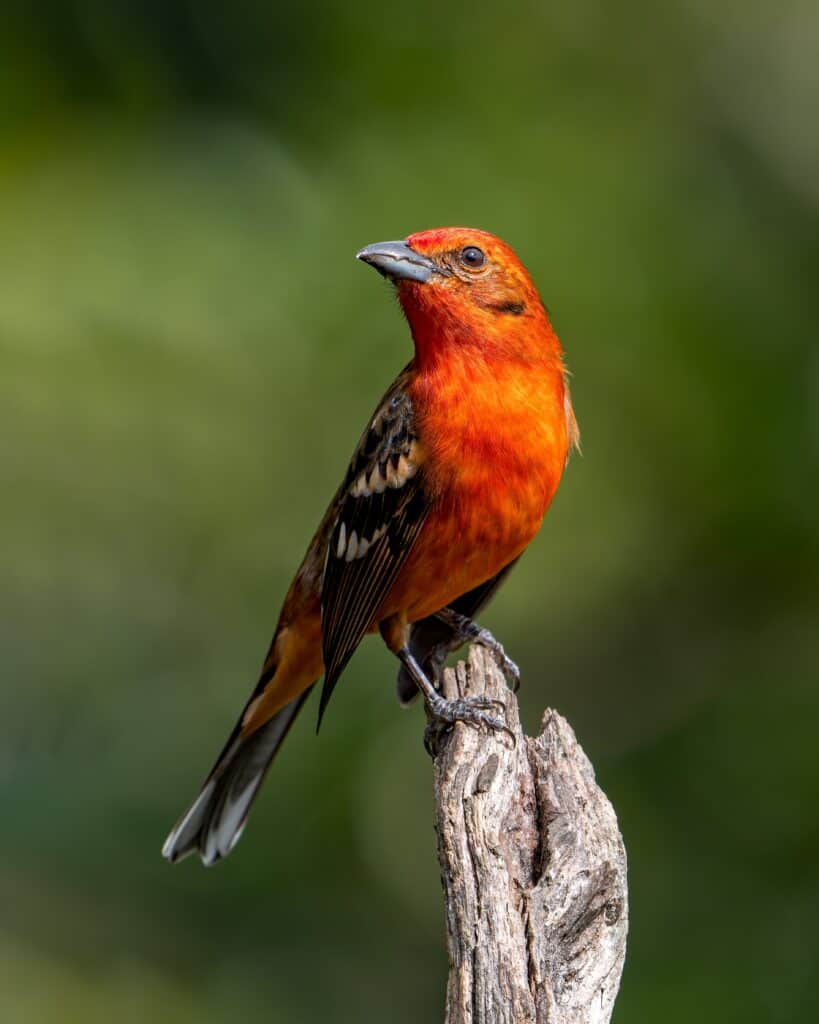
Tanager birds sing for many reasons and often mimic other bird species’ songs.
©Tyler Wenzel/Shutterstock.com
A tanager is a type of songbird that belongs to the family Thraupidae. They are found all over North and South America and come in a variety of colors ranging from brilliant blues and reds to more muted greens and browns. The songs of the tanager are quite varied but generally consist of simple chirps or trills repeated multiple times with slight variations in pitch. The birds sing for many reasons, including mating rituals, territorial defense, or just as an expression of joy at being alive! Tanagers will also sometimes mimic other bird species’ songs as part of their own repertoire.
13. European Starling
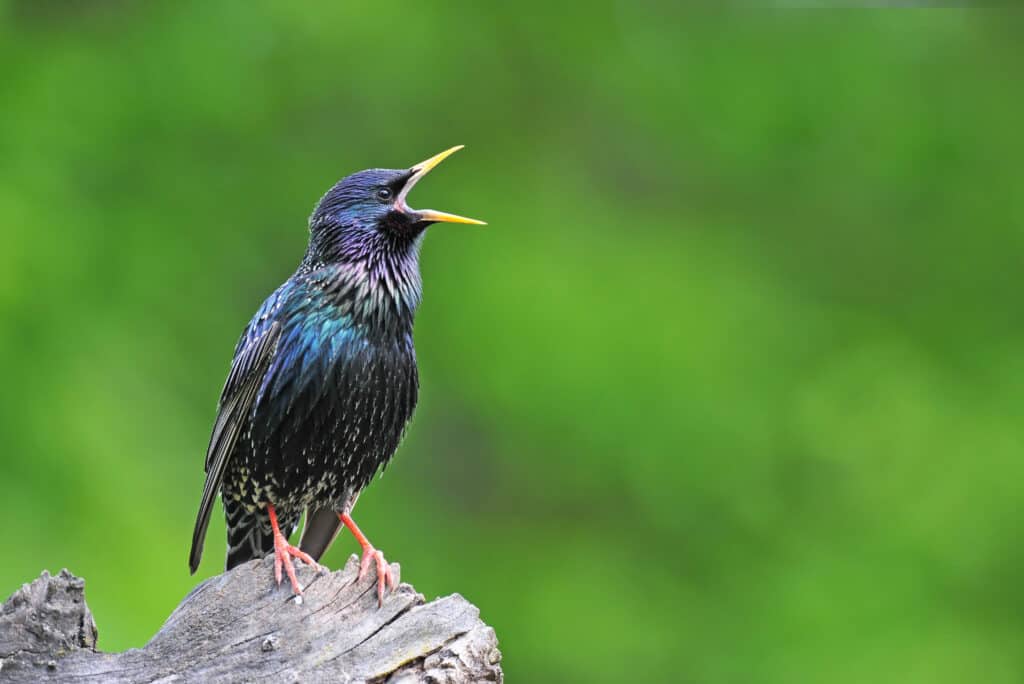
European starlings are excellent mimics and can imitate other birds, machinery, and even human speech.
©Soru Epotok/Shutterstock.com
A European starling is a small black bird that can be found in many parts of Europe, Asia, and North America. They are known for their beautiful song, which consists of mimicked sounds and phrases from other birds as well as notes they create themselves. Starlings have strong memories when it comes to learning new songs, so they often sing the same phrase over and over again. It has been hypothesized that starlings may sing to attract mates or defend their territories, but research is inconclusive regarding the exact purpose of their song. In any case, these tiny creatures provide us with an uplifting soundtrack during our days outdoors!
Summary of The 13 Greatest Songbirds In the World
| Songbird | Song consists of three to four notes followed by a trill | |
|---|---|---|
| 1 | Hermit Thrush | Song consists of flute-like notes that ascend in pitch before ending abruptly |
| 2 | Veery Thrush | Sing multiple notes that become more complex as the bird becomes more excited or agitated |
| 3 | Wood Thrush | Song consists of consists of three to four notes followed by a trill |
| 4 | House Wren | Known to sing at night – females use ultrasonic vocalizations that are used for communication between parents and offspring |
| 5 | Baltimore Oriole | Male Baltimore oriole’s song is a rapid series of thin whistles that sound like “or-lee, or-lee” with an occasional trill at the end |
| 6 | Brown-Streaked Song Sparrow | Song consists of several notes that are often repeated in ascending order |
| 7 | House Finch | Song is composed of sweet, simple notes that sound like “cheerily,” “hirrily,” or “purty purty” |
| 8 | Northern Mockingbird | Known for the variety of its songs – this bird can imitate the sounds of 30 different species |
| 9 | Brown Thrasher | Song consists of loud, melodious whistles interspersed with a variety of harsh notes |
| 10 | Northern Cardinal | sSing a series of clear notes that sound like “what-cheer!” or “purty purty purty” |
| 11 | Rose-Breasted Grosbeak | Song is a melodious mix of whistles and trills that can last up to five minutes |
| 12 | Tanager | Songs are varied but generally consist of simple chirps or trills repeated multiple times with slight variations in pitch |
| 13 | European Starling | Known for their beautiful song, which consists of mimicked sounds and phrases from other birds as well as notes they create themselves |
Thank you for reading! Have some feedback for us? Contact the AZ Animals editorial team.

